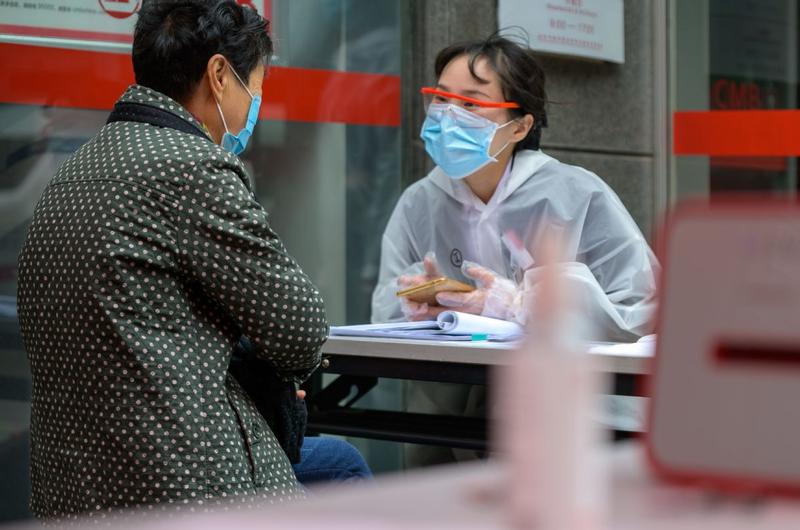 A China Merchants Bank employee, right, addresses customer queries at a branch in Wuhan, Hubei province, on Friday. (YANG KE / FOR CHINA DAILY)
A China Merchants Bank employee, right, addresses customer queries at a branch in Wuhan, Hubei province, on Friday. (YANG KE / FOR CHINA DAILY)
Senior executives at some commercial banks are re-examining their business strategies after financial institutions suffered a blow from the novel coronavirus outbreak.
Affected by the pandemic, the number of customers using China Merchants Bank (CMB) debit and credit cards dropped significantly year-on-year in February. So did the number of small business clients of the bank.
The joint-stock commercial lender headquartered in Shenzhen, Guangdong province, witnessed a decline in the capability and willingness of clients to pay off credit card debt and personal loans. The one-month overdue ratio for its credit card loans, mortgage loans and small business loans largely increased in February from a year earlier, said Tian Huiyu, CMB president.
Many people say that a bank has strong risk-resistance capacity if retail finance contributes a large proportion of its operating income. But this does not mean that the higher the proportion of retail finance income to operating income, the better the bank's performance
Tian Huiyu, President, China Merchants Bank
ALSO READ: IMF expects China's economy to return to normal in Q2
"Many people say that a bank has strong risk-resistance capacity if retail finance contributes a large proportion of its operating income. But this does not mean that the higher the proportion of retail finance income to operating income, the better the bank's performance," Tian said.
The pandemic gave CMB executives a chance to think in depth about the bank's strategic positioning of "one body with two wings" (retail finance as one body and corporate finance and interbank finance as the two wings).
Without strong corporate finance and interbank finance with their special features, retail finance will not get very far, he said.
Last year, the average balance of CMB's total deposits was nearly 4.64 trillion yuan (US$655.4 billion), of which corporate clients contributed 2.97 trillion yuan.
Starting from this year, executives from the bank will devote more energy to creating an integrated combination of retail finance, corporate finance and interbank finance, Tian said.
As a retail banking leader in the world's second largest economy, CMB and its subsidiaries posted 144.72 billion yuan of net operating income from retail finance in 2019, up 15 percent from the previous year, accounting for 53.66 percent of the net operating income of the group, according to the bank's annual results announcement.
Just like CMB, Ping An Bank Co Ltd, another Shenzhen-based joint-stock commercial lender, realized 79.97 billion yuan of operating income from retail finance last year, up 29.2 percent year-on-year, accounting for 58 percent of its operating income.
"In the past, household leverage was relatively low in China, and the government had room to increase household leverage. Many banks regarded retail banking business as an important development direction, partly because of residents' strong demand for financing," said Zeng Gang, deputy director-general of the National Institution for Finance & Development.
"However, problems may emerge if the proportion of retail loans to total loans rises beyond a certain level. In the past few years, China's household leverage increased rapidly, allowing risks to be easily seen when external shocks affect the sustainability of personal income," Zeng said.
Although the ratio of household nonperforming loans was low before, risks associated with these types of loans may grow higher than those of corporate loans as an increase in household debt risks has just begun while risks related to corporate banking have been continuously exposed since 2012 and are drawing to a close, he said.
"In the future, a bank should reconsider what a reasonable proportion of retail banking business is to all business segments," he said. "As the manufacturing sector still has room for growth, industrial upgrading and the construction of new infrastructure may create a new round of demand for financing. Therefore, certain changes in corporate banking and retail banking strategies may occur."
Currently, retail banking contributes between 30 to 40 percent of the operating income of China's listed banks, while corporate banking contributes 50 to 60 percent, and financial markets business 10 to 20 percent, said Wen Bin, chief analyst at China Minsheng Banking Corp.
Wen argued that retail banking is still the direction of transformation of the country's banking sector.
READ MORE: China’s economic growth seen to slow to 5.3% if epidemic eases
"China has switched to a consumption-driven growth model. As personal incomes continue to rise and domestic consumption keeps being upgraded, the retail banking business has enormous growth potential," he said.
As a result of the pandemic, corporate finance has grown rapidly so far this year. In the first quarter, China's new yuan loans reached 7.1 trillion yuan, of which 6.04 trillion yuan were new loans to enterprises and public institutions, according to the central bank.
During the process, banks may strengthen the link between corporate banking and retail banking to better support the real economy, Wen added.


